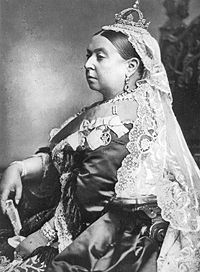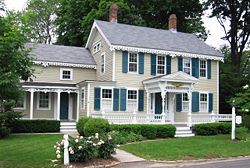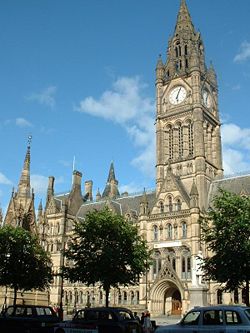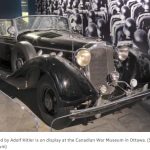Victorian era
The Victorian era of the United Kingdom was the period of Queen Victoria’s rule from June 1837 to January 1901 [1]. This was a long period of prosperity for the British people, as profits gained from the overseas British Empire, as well as from industrial improvements at home, allowed a large, educated middle class to develop. Some scholars would extend the beginning of the period—as defined by a variety of sensibilities and political concerns that have come to be associated with the Victorians—back five years to the passage of the Reform Act 1832.
The era was preceded by the Georgian period and succeeded by the Edwardian period. The latter half of the Victorian era roughly coincided with the first portion of the Belle ?poque era of continental Europe and other non-English speaking countries within Europe.
The era is often characterized as a long period of peace, known as the Pax Britannica, and economic, colonial, and industrial consolidation, temporarily disrupted by the Crimean War, although Britain was at war every year during this period. Towards the end of the century, the policies of New Imperialism led to increasing colonial conflicts and eventually the Anglo-Zanzibar War and the Boer War. Domestically, the agenda was increasingly liberal with a number of shifts in the direction of gradual political reform and the widening of the voting franchise.
The population of England had more than doubled from 16.8 million in 1851 to 30.5 million in 1901.[2] Ireland’s population decreased rapidly, from 8.2 million in 1841 to less than 4.5 million in 1901.[3]
In the early part of the era the House of Commons was dominated by the two parties, the Whigs and the Tories. From the late 1850s onwards the Whigs became the Liberals even as the Tories became known as the Conservatives. These parties were led by many prominent statesmen including Lord Melbourne, Sir Robert Peel, Lord Derby, Lord Palmerston, William Gladstone, Benjamin Disraeli and Lord Salisbury. The unsolved problems relating to Irish Home Rule played a great part in politics in the later Victorian era, particularly in view of Gladstone’s determination to achieve a political settlement.

Queen Victoria, after whom the era is named.
1837—1901
Preceded by Georgian period
Followed by Edwardian period
Culture
The Victorian fascination with novelty resulted in a deep interest in the relationship between modernity and cultural continuities. Gothic Revival architecture became increasingly significant in the period, leading to the Battle of the Styles between Gothic and Classical ideals. Charles Barry’s architecture for the new Palace of Westminster, which had been badly damaged in an 1834 fire, built on the medieval style of Westminster Hall, the surviving part of the building. It constructed a narrative of cultural continuity, set in opposition to the violent disjunctions of Revolutionary France, a comparison common to the period, as expressed in Thomas Carlyle’s The French Revolution: A History and Charles Dickens’ A Tale of Two Cities. Gothic was also supported by the critic John Ruskin, who argued that it epitomised communal and inclusive social values, as opposed to Classicism, which he considered to epitomise mechanical standardisation.
The middle of the century saw The Great Exhibition of 1851, the first World’s Fair and showcased the greatest innovations of the century. At its centre was the Crystal Palace, an enormous, modular glass and iron structure – the first of its kind. It was condemned by Ruskin as the very model of mechanical dehumanisation in design, but later came to be presented as the prototype of Modern architecture. The emergence of photography, which was showcased at the Great Exhibition, resulted in significant changes in Victorian art. John Everett Millais was influenced by photography (notably in his portrait of Ruskin) as were other Pre-Raphaelite artists. It later became associated with the Impressionistic and Social Realist techniques that would dominate the later years of the period in the work of artists such as Walter Sickert and Frank Holl.
Events
1832
Passage of the first Reform Act.[4]
1837
Ascension of Queen Victoria to the throne.[4]
1840
New Zealand becomes a British colony, through the Treaty of Waitangi
1842
Massacre of Elphinstone’s Army in Afghanistan.[5]
1842
The Mine Act banned women and children from working in coal, iron, lead and tin mining.[4]
1845
The Irish famine begins. Within 5 years it would become the UK’s worst human disaster, with starvation and emigration reducing the population of the entire country by 7.5%. The effect of the famine permanently changed Ireland’s demographic and became a rallying point for nationalist sentiment that pervaded British politics for much of the following century.
1846
Repeal of the Corn Laws.[4]
1848
Death of around 2,000 people a week in a cholera epidemic.
1850
Restoration of the Roman Catholic hierarchy in Britain.
1851
The Great Exhibition (the first World’s Fair) was held at the Crystal Palace[4], with great success and international attention.
1854
Crimean War: The United Kingdom declared war on Russia.
1857
The Indian Mutiny, a widespread revolt in India against the rule of the British East India Company, was sparked by sepoys (native Indian soldiers) in the Company’s army. The rebellion, involving not just sepoys but many sectors of the Indian population as well, was largely quashed within a year. In response to the mutiny, the East India Company was abolished in August 1858 and India came under the direct rule of the British crown, beginning the period of the British Raj.
1858
The Prime Minister, Lord Palmerston, responded to the Orsini plot against French emperor Napoleon III, the bombs for which were purchased in Birmingham, by attempting to make such acts a felony, but the resulting uproar forced him to resign.
1859
Charles Darwin published On the Origin of Species, which led to various reactions.[4]
1861
Death of Prince Albert[4]; Queen Victoria refused to go out in public for many years, and when she did she wore a widow’s bonnet instead of the crown.
1866
An angry crowd in London, protesting against John Russell’s resignation as Prime Minister, was barred from Hyde Park by the police; they tore down iron railings and trampled on flower beds. Disturbances like this convinced Derby and Disraeli of the need for further parliamentary reform.
1875
Britain purchased Egypt’s shares in the Suez Canal[4] as the African nation was forced to raise money to pay off its debts.
1882
British troops began the occupation of Egypt by taking the Suez Canal, in order to secure the vital trade route and the passage to India, and the country became a protectorate.
1884
The Fabian Society was founded in London by a group of middle class intellectuals, including Quaker Edward R. Pease, Havelock Ellis, and E. Nesbit, to promote socialism.
1888
The serial killer known as Jack the Ripper murdered and mutilated five (and possibly more) prostitutes on the streets of London.[4]
1870 – 1891
Under the Elementary Education Act 1870 basic State Education became free for every child under the age of 10.
Entertainment
Popular forms of entertainment varied by social class. Victorian Britain, like the periods before it, was interested in theatre and the arts, and music, drama, and opera were widely attended. There were, however, other forms of entertainment. Gambling at cards in establishments popularly called casinos was wildly popular during the period: so much so that evangelical and reform movements specifically targeted such establishments in their efforts to stop gambling, drinking, and prostitution.
Brass bands and ‘The Bandstand’ became popular in the Victorian era. The band stand was a simple construction that not only created an ornamental focal point, but also served acoustic requirements whilst providing shelter from the changeable British weather. It was common to hear the sound of a brass band whilst strolling through parklands. At this time musical recording was still very much a novelty.
Another form of entertainment involved ‘spectacles’ where paranormal events, such as hypnotism, communication with the dead (by way of mediumship or channelling), ghost conjuring and the like, were carried out to the delight of crowds and participants. Such activities were more popular at this time than in other periods of recent Western history.
Technology and engineering
The impetus of the Industrial Revolution had already occurred, but it was during this period that the full effects of industrialization made themselves felt, leading to the mass consumer society of the 20th century. The revolution led to the rise of railways across the country and great leaps forward in engineering, most famously by Isambard Kingdom Brunel.
Another great engineering feat in the Victorian Era was the sewage system in London. It was designed by Joseph Bazalgette in 1858. He proposed to build 82 mi (132 km) of sewerage linked with over 1,000 mi (1,600 km) of street sewers. Many problems were found but the sewers were completed. After this, Bazalgette designed the Thames Embankment which housed sewers, water pipes and the London Underground. During the same period London’s water supply network was expanded and improved, and gas reticulation for lighting and heating was introduced in the 1880s.
During the Victorian era, science grew into the discipline it is today. In addition to the increasing professionalism of university science, many Victorian gentlemen devoted their time to the study of natural history.
Photography was realized in 1829 by Louis Daguerre in France and William Fox Talbot in the UK. By 1900, hand-held cameras were available.
Although initially developed in the early years of the 19th century, gas lighting became widespread during the Victorian era in industry, homes, public buildings and the streets. The invention of the incandescent gas mantle in the 1890s greatly improved light output and ensured its survival as late as the 1960s. Hundreds of gasworks were constructed in cities and towns across the country. In 1882, incandescent electric lights were introduced to London streets, although it took many years before they were installed everywhere.
Child labour
The Victorian era became notorious for employing young children in factories and mines and as chimney sweeps. Several Factory Acts were passed to prevent the exploitation of children in the workplace. Children of poor families would leave school at the age of eight and were then forced to go to work. School was not free at this time. All of these jobs came with dangers. Many children got stuck in the chimneys that they were sweeping, and in factories it was not uncommon for children to lose limbs crawling under machinery to pick things up. Children also did not have the rights that they have today. Breaks were unheard of, days were much longer, and they earned very little money.
Prostitution
Beginning in the late 1840s, major news organisations, clergymen and single women became increasingly concerned about prostitution, which came to be known as “The Great Social Evil.” Although estimates of the number of prostitutes in London by the 1850s vary widely (in his landmark study, Prostitution, William Acton reported that the police estimated there were 8,600 in London alone in 1857), it is enough to say that the number of women working the streets became increasingly difficult to ignore.
When the United Kingdom Census 1851 publicly revealed a 4% demographic imbalance in favour of women (i.e. 4% more women than men), the problem of prostitution began to shift from a moral/religious cause to a socio-economic one. The 1851 census showed that the population of Great Britain was roughly 18 million; this meant that roughly 750,000 women would remain unmarried simply because there were not enough men. These women came to be referred to as “superfluous women” or “redundant women,” and many essays were published discussing what, precisely, ought to be done with them.
While the Magdalene Asylums had been “reforming” prostitutes since the mid-18th century, the years between 1848 and 1870 saw a veritable explosion in the number of institutions working to “reclaim” these “fallen women” from the streets and retrain them for entry into respectable society—usually for work as domestic servants. The theme of prostitution and the “fallen woman” (an umbrella term used to describe any women who had sexual intercourse out of wedlock) became a staple feature of mid-Victorian literature and politics. In the writings of Henry Mayhew, Charles Booth and others, prostitution began to be seen as a social problem.
When Parliament passed the first of the Contagious Diseases Acts in 1864 (which allowed the local constabulary to force any woman suspected of venereal disease to submit to its inspection), Josephine Butler’s crusade to repeal the CD Acts yoked the anti-prostitution cause with the emergent feminist movement. Butler attacked the long-established double standard of sexual morality.
Prostitutes were often presented as victims in sentimental literature such Thomas Hood’s poem The Bridge of Sighs, Elizabeth Gaskell’s novel Mary Barton and Dickens’ novel Oliver Twist. The emphasis on the purity of women found in such works as Coventry Patmore’s The Angel in the House led to the portrayal of the prostitute and fallen woman as soiled, corrupted, and in need of cleansing.
This emphasis on female purity was allied to the stress on the homemaking role of women, who helped to create a space free from the pollution and corruption of the city. In this respect the prostitute came to have symbolic significance as the embodiment of the violation of that divide. The double standard remained in force. Divorce legislation introduced in 1857 allowed for a man to divorce his wife for adultery, but a woman could only divorce if adultery was accompanied by cruelty. The anonymity of the city led to a large increase in prostitution and unsanctioned sexual relationships. Dickens and other writers associated prostitution with the mechanisation and industrialisation of modern life, portraying prostitutes as human commodities consumed and thrown away like refuse when they were used up. Moral reform movements attempted to close down brothels, something that has sometimes been argued to have been a factor in the concentration of street-prostitution in Whitechapel, in the East End of London, by the 1880s.
By the time the CD Acts were repealed in 1886, Victorian Britain had been completely transformed. This era, which at its outset looked no different from the century before it, would end resembling much more the era that would follow.
See also
Victorian architecture
Victorian decorative arts
Victorian fashion
Victorian morality
Victorian literature
History of British society
Horror Victorianorum
Imperialism
Victoriana
Neo-Victorian
Workhouse
http://en.wikipedia.org/wiki/Victorian_era
Victorian architecture
The term Victorian architecture can refer to one of a number of architectural styles predominantly employed during the Victorian era. As with the latter, the period of building that it covers may slightly overlap the actual reign, 20 June 1837 – 22 January 1901, of Queen Victoria after whom it is named.

Example of an early Victorian “Gingerbread House” in the USA, built in 1855

Manchester Town Hall is an example of Victorian architecture found in Manchester, UK.
Varieties of Victorian architecture
British Arts and Crafts movement
Gothic Revival
Italianate
Jacobethan (the precursor to the Queen Anne style)
Neoclassicism
Neo-Grec
Painted ladies
Queen Anne
Renaissance Revival
Romanesque Revival (includes Richardsonian Romanesque)
Second Empire
Stick-Eastlake
Industrial architecture
There are also Folk and Shingle Style Victorian Houses. Please note that the names of architectural styles (as well as their adaptations) varied between countries. Many homes combined the elements of several different styles and are not easily distinguishable as one particular style or another. In the USA, Highly decorated houses are sometimes called gingerbread houses.
Notable Victorian era cities include London, Boston, Richmond, Saint Paul, St. Louis, Louisville, Galena, IL, Galveston, San Francisco, Chicago, Glasgow, Sydney, Melbourne, Manchester, Mumbai, Pittsburgh, Grand Rapids, MI, and New Orleans.
In the USA, the South End of Boston is recognized by the National Register of Historic Places as the oldest and largest Victorian neighborhood in the country.[1][2][3] Old Louisville in Louisville, Kentucky also claims to be the nation’s largest Victorian neighborhood.
Richmond, Virginia is home to several large Victorian neighborhoods, the most prominent being The Fan and Church Hill. Church Hill has the distinction of being the place where Patrick Henry gave his famous Give me liberty or give me death speech at historic Saint John’s church. The Fan is best known locally as Richmond’s largest and most ‘European’ of Richmond’s neighborhoods and nationally as the largest contiguous Victorian neighborhood in the United States.[4]
The Distillery District in Toronto contains the largest and best preserved collection of Victorian-era industrial architecture in North America.
The photo album L’Architecture Americaine by Albert Levy published in 1886 is perphaps the first recognition in Europe of the new forces emerging in American architecture[5].
The Old West End neighborhood of Toledo, Ohio is recognized as having the largest collection of late Victorian and Edwardian homes in the United States , East of the Mississippi.[6]
Carroll Avenue in Los Angeles contains that city’s highest concentration of Victorian homes.
See also: Georgian architecture.
http://en.wikipedia.org/wiki/Victorian_architecture
维多利亚式房屋
维多利亚式房屋是指英国维多利亚女王在位时(1837 to 1901)所出现的特殊住宅风格。本时期英国国力突飞猛进,由于发生工业革命,英国人民的经济水平同时大幅度提升,对于住宅也越发追求精美,同时物资也开始大量生产对市场提供,人们的追求以及资源材料的丰富形成了不同于以往的一种建筑风格,至今都还影响着住宅的设计。
特征
维多利亚式房屋大多具有下列特征:
-尖尖的屋顶
-窗户伸出了房屋的墙壁
-屋外有栏杆围绕的走廊和阳台,而且有屋顶覆盖
-外墙覆以鱼鳞般的木片
-建有一座尖塔
-屋顶上还有窗户伸出,上覆屋顶
-圆形或方形的立柱
-精细的装饰
整座建筑物散发精雕细啄的感觉。
分布
在美国,仍存在大量维多利亚式房屋的城市包括波士顿,旧金山,匹兹堡,纽奥良,维吉尼亚州里奇蒙,明尼苏达州圣保罗,肯塔基州路易维尔等.
http://zh.wikipedia.org/wiki/%E7%B6%AD%E5%A4%9A%E5%88%A9%E4%BA%9E%E5%BC%8F
什么是维多利亚式建筑?有些什么重要的特征呢?
维多利亚式建筑是一个很笼统提法.因为它覆盖了许多不同的风格.一般的看法是拿破仑扩张主义的破灭就是该时代的开始,历经维多利亚王统治至1914年的第一次世界大战到达顶峰.时间上是大约由1840到1900.该期的建筑特色不仅打上了当时的政治烙印,也反映了广大中产阶层在工业革命时间日益增加的需求.工业革命的发展对当时建筑的影响主要体现在两方面.一是信息交流的极大提高.当一个建筑商创造出一个新的样板时就很快传遍到各地,别的建筑商会将各种不同的风格揉和在一起产生独特的流派.另一方面是建筑材料生产的工业化,如拱形支架,栏杆的纺缍形立柱等等.油毡的应用也启于此阶段,房屋的装饰也开始应用不同的颜色,深色和鲜亮的颜色在十九世纪后期变为时尚.纹理漆的应用,大理石墙面,镀金装饰变为普遍.纺织品的工业化降低了成本使其在装饰材料中有了重要的地位.
一般特点:
当我们提到维多利亚式建筑时脑海中浮现的图像一般是这样的:鲜艳华丽的房子,三角形山墙,房顶高耸,屋檐突出,轴轮状或扇形斗拱,有时尚有角楼,带门廓柱的阳台.多种不同颜色的使用也很普通.
分类特色:
1.维多利亚意大利式:此式样时间上大约在1850到1880.自诩与传统的经典结构相决裂,可尽管表面上方方正正似与传统相背,骨子里仍与传统割不断,极尽装饰华丽.以低房顶,装饰性斗拱和宽房檐为特点.其它特征包括正面对称性凸窗(Bay windows),窄而高的窗户,柱子,窗子和门框上精细的图案.
2.棒条板结构:此类结构以细微处见精致而自喻.但由于过于精细以致于没有几间房子拥有所有特点.总体上讲有高耸的房顶带悬垂,木制瓦板覆盖着外墙和房顶.水平的垂直的对角的本板装饰着表层和门廊.这就是被称为棒条板结构的原因.
3.皇王安妮式:此期的建筑更是将该期的政治风情表现得淋漓尽致.在材料上采用折衷主义,在装饰上到了卖弄风情的地步.其特点是高耸的房顶和角楼,窗户高而窄垂直长方形.房形上是多层结构带侧翼,多个门廊和阳台.有时烟囱也好几个.木制的鱼鳞般卷曲而圆滑的装饰片为山墙和门廊增添了魅力.
4哥特式复兴主义:中世纪的传统与当时方法的结合之产物.发生在1840-1880.借用了许多中世纪大教堂的特点,如拱弓,尖顶窗户.
5.二世帝国式.由法国拿破仑二世时期的建筑得到启示以盒式复折式房顶为特点
6.其它:除此之外还有浪漫式,平民式和房顶板式.
至于殖民风格的建筑,我不太明白,应该是由殖民地的建筑文化和统治者的建筑文化糅合在一起的风格吧!由于这二者的不统一,融合起来不同殖民地的风格可能也不会一样。但应由欧式风格为主吧
http://ks.cn.yahoo.com/question/1406030200894.html
Architectural Timeline : Victorian
Victorian 1837 – 1914
The early decades of the Victorian Era saw the full flowering of the industrial revolution. For the first time, mass production of hardware and supplies made products readily available and affordable to increasingly more people. The prominence of handmade craftsmanship quickly gave way to machine manufacturing. House styles were breaking free from their box-like shapes, with asymmetrical floor planning and elaborate exterior features.
The Victorian Era marked the explosion of creative options and the emergence of intricate, daring forms and techniques available to the homeowner as never before. Designers and architects broke away from the traditional symmetrical lines and simple colors. Victorian homes are colorful, elaborate, and bold.
——————————————————————————–
Gothic Revival
Early Victorian houses drew inspiration mostly from Western Europe, usually reinterpreting medieval forms. Multi-colored and textured walls, steeply pitched roofs and asymmetrical facades are traditional features. Gothic Revival homes are most easily identified by the elaborate vergeboard (also called gingerbread) below the gables, and the strong vertical emphasis of the windows and rooflines.
Italianate
As the architectural influence of the Federal Era blended with the emerging Victorian aesthetic, a new style developed, incorporating the arches and pediments of Roman architecture with the elaborate detailing made possible by the emerging industrial base of the growing nation. Italianate homes featured elaborate porch decoration, decorative eaves, symmetrical facades with corner quoins, and arched windows which were often paired. Some Italianate homes featured a central square tower or cupola, and most had flat or low-pitched roofs. The Italianate style later influenced the rise of Richardsonian Romanesque; a style prevalent in many of the large public buildings built during the late 1800’s.
Second Empire
As the newly prospering cities of America blossomed, the impulse for a new and equally vigorous urban architecture also grew. Inspired by the ornate cityscapes of Paris, Second Empire architecture incorporates rectangular or square floor plans, tall flat facades capped by Mansard roofs with dormer windows, and double entry doors. Roofs are frequently patterned and bay windows are also common.
Stick / Eastlake
Increasingly affordable building materials and woodworking allowed for creative new uses of wood cladding and framing beyond the basic box structure. Stick / Eastlake style homes feature decorative trusswork, exposed half-timber framing, and an intermingling of vertical and horizontal planes. Roofs are typically steeply pitched with simple gables. Stick style houses are particularly common in California and other areas where no previous architectural style had predominated.
Shingle
Similar to Stick style architecture, Shingle style buildings are notable for their extensive and unusual use of newly affordable wood products. Manufacturing techniques made it possible to produce wood shingles in such abundance that architects incorporated them not only as roofing, but also as siding. In Shingle style houses, the entire exterior sometimes consists of shingles.
Folk Victorian
Given the affordable and widespread construction techniques of the era, working class families could, for the first time, build homes of their own. The tradition of the English cottage and American homestead merged with the romanticism of the era, giving rise to the style known as Folk Victorian. Often found in rural or country settings, Folk Victorian homes are usually constructed from local materials and blend functionality with newer stylistic ornamentation that includes colorful and fluid vergeboard (also called gingerbread) around wide wrap-around porches. Though often less elaborate than their urban counterparts, Folk Victorian homes feature a similar attention to texture variations and creative decoration.
Queen Anne
Perhaps the most recognizable of Victorian styles, Queen Anne houses quickly gained popularity throughout the entire country from the late 1870’s to the beginning of the 1900’s. The Queen Anne style shows the influence of English architect Richard Norman Shaw, whose designs melded the ideals of the old-English cottage with the rampant decorative impulse of the Victorian Era. Queen Anne homes frequently feature irregular floor plans, multiple steep roofs and porches with decorative gables. Dominant octagonal or circular towers, corbelled chimneys, and highly decorative windows and entry doors with glass panels add to the curb appeal of these beautiful homes. Common elaborations include vergeboard and exterior framing, bay windows, and a wide variety of colors and textures throughout the entire structure.
Gilded Age / Beaux Arts
Infrequently used in home-building except in the most expansive of mansions, Beaux Arts designs are nevertheless important in the influence they exerted on the period. Also called “The American Renaissance”, Beaux Arts architecture features massive stone bearing walls, large arched windows, porches, and entries, paired columns, extensive use of sculpture and bas-relief stonework, and grandly scaled interiors reminiscent of the great palaces of Europe.
Victorian Hardware
America’s Industrial Revolution led to an explosion of new hardware styles and techniques. Brass and bronze were used extensively, as traditional forging methods were replaced by cheaper methods of metalworking. Charles Eastlake’s “Hints on House Hold Taste” popularized the concept of elaborate hardware. In 1872, Russell & Erwin started mass-producing standard hardware types and soon most pieces found in Victorian homes were created in a factory rather than a craftsman’s workshop. The availability of new technologies such as electrical power and central heat also created unique opportunities in hardware design. Common hardware included the mortise lock, cabinet knobs and bin pulls, entry doorsets with plate and latch combined, and offset hinges. Innovations include push-button electrical switches, brass floor registers, thumb-turn and electrical doorbells, and decorative doorknobs.
Significant Dates
1837: Queen Victoria I begins reign in United Kingdom.
1848: Treaty of Guadalupe Hidalgo. European and American immigrants populate the newly opened territories, spreading American architectural forms into Texas, California, and the Midwest.
1865: Transcontinental Railroad finished, speeding America’s industrialization and westward expansion.
1867: Exhibition in Paris marks the spread of the 2nd Empire style into America.
1868: Charles Eastlake publishes “Hints on House Hold Taste” the codex on Victorian Design.
1869: Completion of the Corcoran Gallery of Art, 2nd Empire architecture.
1869: M.C.C.C. (Metal Compression Casting Company) awarded its first patent for decorative hardware.
1872: Beginning of Russell & Erwin hardware mfg., first casting of hardware on a large scale.
1890: Louis Sullivan designs the Wainwright Bldg. — considered by some the first skyscraper.
1893: Chicago’s Columbian Exposition marks the launching pad of the Colonial Revival.
1914—1918: World War I marks the decline of Victorian styles.
http://houseofantiquehardware.com/site/timeline/tl_victorian.html



